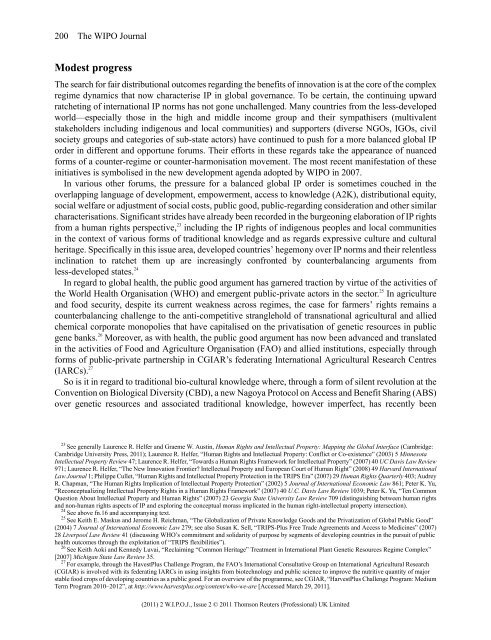WIPO Journal - World Intellectual Property Organization
WIPO Journal - World Intellectual Property Organization
WIPO Journal - World Intellectual Property Organization
Create successful ePaper yourself
Turn your PDF publications into a flip-book with our unique Google optimized e-Paper software.
200 The <strong>WIPO</strong> <strong>Journal</strong><br />
Modest progress<br />
The search for fair distributional outcomes regarding the benefits of innovation is at the core of the complex<br />
regime dynamics that now characterise IP in global governance. To be certain, the continuing upward<br />
ratcheting of international IP norms has not gone unchallenged. Many countries from the less-developed<br />
world—especially those in the high and middle income group and their sympathisers (multivalent<br />
stakeholders including indigenous and local communities) and supporters (diverse NGOs, IGOs, civil<br />
society groups and categories of sub-state actors) have continued to push for a more balanced global IP<br />
order in different and opportune forums. Their efforts in these regards take the appearance of nuanced<br />
forms of a counter-regime or counter-harmonisation movement. The most recent manifestation of these<br />
initiatives is symbolised in the new development agenda adopted by <strong>WIPO</strong> in 2007.<br />
In various other forums, the pressure for a balanced global IP order is sometimes couched in the<br />
overlapping language of development, empowerment, access to knowledge (A2K), distributional equity,<br />
social welfare or adjustment of social costs, public good, public-regarding consideration and other similar<br />
characterisations. Significant strides have already been recorded in the burgeoning elaboration of IP rights<br />
from a human rights perspective, 23 including the IP rights of indigenous peoples and local communities<br />
in the context of various forms of traditional knowledge and as regards expressive culture and cultural<br />
heritage. Specifically in this issue area, developed countries’ hegemony over IP norms and their relentless<br />
inclination to ratchet them up are increasingly confronted by counterbalancing arguments from<br />
less-developed states. 24<br />
In regard to global health, the public good argument has garnered traction by virtue of the activities of<br />
the <strong>World</strong> Health Organisation (WHO) and emergent public-private actors in the sector. 25 In agriculture<br />
and food security, despite its current weakness across regimes, the case for farmers’ rights remains a<br />
counterbalancing challenge to the anti-competitive stranglehold of transnational agricultural and allied<br />
chemical corporate monopolies that have capitalised on the privatisation of genetic resources in public<br />
gene banks. 26 Moreover, as with health, the public good argument has now been advanced and translated<br />
in the activities of Food and Agriculture Organisation (FAO) and allied institutions, especially through<br />
forms of public-private partnership in CGIAR’s federating International Agricultural Research Centres<br />
(IARCs). 27<br />
So is it in regard to traditional bio-cultural knowledge where, through a form of silent revolution at the<br />
Convention on Biological Diversity (CBD), a new Nagoya Protocol on Access and Benefit Sharing (ABS)<br />
over genetic resources and associated traditional knowledge, however imperfect, has recently been<br />
23<br />
See generally Laurence R. Helfer and Graeme W. Austin, Human Rights and <strong>Intellectual</strong> <strong>Property</strong>: Mapping the Global Interface (Cambridge:<br />
Cambridge University Press, 2011); Laurence R. Helfer, “Human Rights and <strong>Intellectual</strong> <strong>Property</strong>: Conflict or Co-existence” (2003) 5 Minnesota<br />
<strong>Intellectual</strong> <strong>Property</strong> Review 47; Laurence R. Helfer, “Towards a Human Rights Framework for <strong>Intellectual</strong> <strong>Property</strong>” (2007) 40 UC Davis Law Review<br />
971; Laurence R. Helfer, “The New Innovation Frontier? <strong>Intellectual</strong> <strong>Property</strong> and European Court of Human Right” (2008) 49 Harvard International<br />
Law <strong>Journal</strong> 1; Philippe Cullet, “Human Rights and <strong>Intellectual</strong> <strong>Property</strong> Protection in the TRIPS Era” (2007) 29 Human Rights Quarterly 403; Audrey<br />
R. Chapman, “The Human Rights Implication of <strong>Intellectual</strong> <strong>Property</strong> Protection” (2002) 5 <strong>Journal</strong> of International Economic Law 861; Peter K. Yu,<br />
“Reconceptualizing <strong>Intellectual</strong> <strong>Property</strong> Rights in a Human Rights Framework” (2007) 40 U.C. Davis Law Review 1039; Peter K. Yu, “Ten Common<br />
Question About <strong>Intellectual</strong> <strong>Property</strong> and Human Rights” (2007) 23 Georgia State University Law Review 709 (distinguishing between human rights<br />
and non-human rights aspects of IP and exploring the conceptual morass implicated in the human right-intellectual property intersection).<br />
24<br />
See above fn.16 and accompanying text.<br />
25<br />
See Keith E. Maskus and Jerome H. Reichman, “The Globalization of Private Knowledge Goods and the Privatization of Global Public Good”<br />
(2004) 7 <strong>Journal</strong> of International Economic Law 279; see also Susan K. Sell, “TRIPS-Plus Free Trade Agreements and Access to Medicines” (2007)<br />
28 Liverpool Law Review 41 (discussing WHO’s commitment and solidarity of purpose by segments of developing countries in the pursuit of public<br />
health outcomes through the exploitation of “TRIPS flexibilities”).<br />
26<br />
See Keith Aoki and Kennedy Luvai, “Reclaiming “Common Heritage” Treatment in International Plant Genetic Resources Regime Complex”<br />
[2007] Michigan State Law Review 35.<br />
27<br />
For example, through the HavestPlus Challenge Program, the FAO’s International Consultative Group on International Agricultural Research<br />
(CGIAR) is involved with its federating IARCs in using insights from biotechnology and public science to improve the nutritive quantity of major<br />
stable food crops of developing countries as a public good. For an overview of the programme, see CGIAR, “HarvestPlus Challenge Program: Medium<br />
Term Program 2010–2012”, at http://www.harvestplus.org/content/who-we-are [Accessed March 29, 2011].<br />
(2011) 2 W.I.P.O.J., Issue 2 © 2011 Thomson Reuters (Professional) UK Limited

















